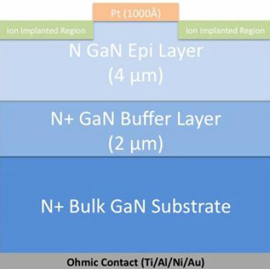- News
2 February 2011
NC State’s argon buffer boosts GaN device power handling 10-fold
 Gallium nitride (GaN) material can facilitate emerging high-power devices that are more energy efficient than existing technologies, but GaN devices traditionally break down when exposed to high voltages. Now, researchers in the Department of Electrical and Computer Engineering on North Carolina State University’s Centennial Campus claim to have solved this problem.
Gallium nitride (GaN) material can facilitate emerging high-power devices that are more energy efficient than existing technologies, but GaN devices traditionally break down when exposed to high voltages. Now, researchers in the Department of Electrical and Computer Engineering on North Carolina State University’s Centennial Campus claim to have solved this problem.
Picture: Argon buffer is marked in green and labeled 'ion implanted region'. Credit: Merve Ozbek.
“For future renewable technologies, such as the smart grid or electric cars, we need high-power semiconductor devices, and power-handling capacity is important for the development of those devices,” says Ph.D. student Merve Ozbek, author of the paper ‘Planar, Nearly Ideal Edge Termination Technique for GaN Devices’ (to be published in IEEE’s Electron Device Letters).
Previously, research into developing high-power GaN devices has run into obstacles, because large electric fields can be created at specific points on the devices’ edge when high voltages are applied, effectively destroying the devices. NC State researchers have addressed the problem by implanting a buffer made of the neutral element argon at the edges of GaN devices to form a high resistive amorphous layer. The buffer spreads out the electric field away from these small areas, preventing premature breakdown and allowing the device to handle much higher voltages.
The researchers tested the new technique by fabricating GaN Schottky diodes both with and without the argon implant. They found that the diodes that did not have the argon implant broke down when exposed to a voltage of about 250V, whereas the diodes with the argon implant could handle up to 1650V (a voltage almost seven times higher) before breaking down.
“By improving the breakdown voltage from 250V to 1650V, we can reduce the electrical resistance of these devices 100-fold,” notes the paper’s co-author Dr Jay Baliga, Distinguished University Professor of Electrical and Computer Engineering. “That reduction in resistance means that these devices can handle 10 times as much power.”
The research was supported by NC State’s Future Renewable Electric Energy Delivery and Management Systems Center, with funding from the US National Science Foundation.
http://ieeexplore.ieee.org/xpl/freeabs_all.jsp?arnumber=5680581
